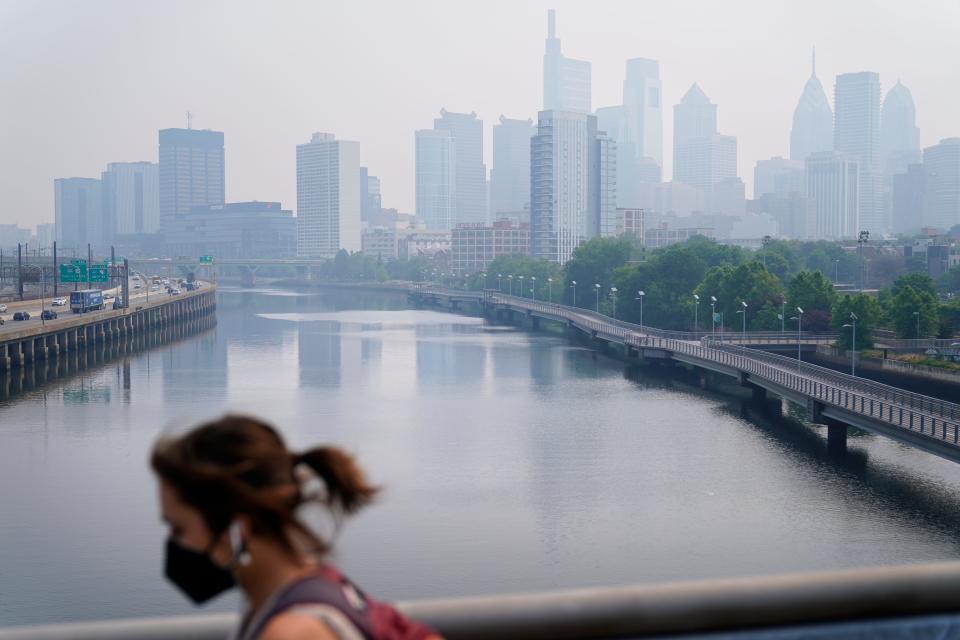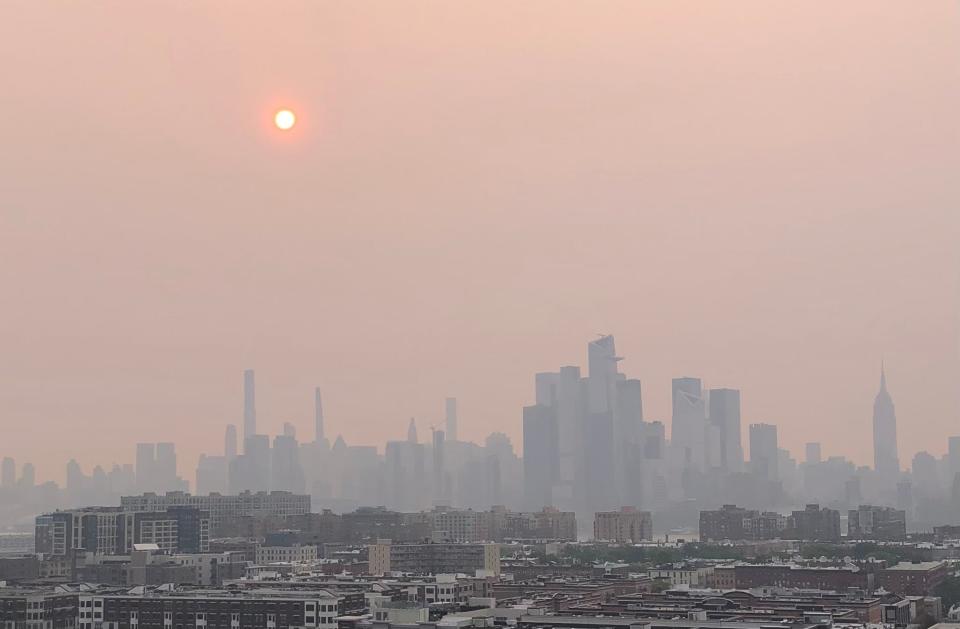Is the air quality in Bucks County improving today? And is it safe to go outside yet?
Air quality started to improve Thursday, but officials say residents should continue to stay indoors, if possible, even as the haze and smoke start to dissipate.
By Thursday afternoon, communities across the county found themselves back down to Code Red conditions with decreased health risks, days after smoke descended over the region from the wildfires in Canada.
However, in a press release issued Thursday, the Pennsylvania Department of Environmental Protection continued to urge residents to take precautions, especially sensitive groups, such as young children, the elderly, and those with respiratory problems, such as asthma, emphysema, and bronchitis.
“Smoke due to wildfires in eastern Canada will likely contribute to daily average concentrations of fine particulate matter in the Code Red and Code Orange range on Thursday,” the EPA said.
“The weather pattern pushing the smoke from wildfires in eastern Quebec is forecast to continue until Friday for most of Pennsylvania, with conditions improving throughout the day on Thursday.”

During a Code Red, sensitive groups should avoid long or intense outdoor activities and consider rescheduling or moving activities indoors. Everyone else is advised to reduce long or intense activities and take more breaks during outdoor activities.
See how different parts of Bucks County were affected over the past 24 hours:
Upper Bucks towns were the hardest hit in the county
By Wednesday afternoon, the air quality index was reported at its highest alert level, Code Maroon, in Upper Bucks communities, such as Perkasie and Quakertown, and continued to worsen in the overnight hours, according to AirNow.gov.
Code Maroon indicates hazardous health conditions, during which everyone should avoid all physical outdoor activities and sensitive groups are advised to remain indoors and keep activity levels low.
As of 3 p.m. Thursday, the air quality index in Upper Bucks was reported at Code Red levels, indicating unhealthy conditions. For the latest air quality conditions in specific cities, go to AirNow.gov.
Central Bucks worsened overnight to hazardous levels before improving
In Central Bucks communities — including Doylestown, Warminster and Newtown — levels reached Code Purple conditions, as of Wednesday afternoon, meaning air quality had reached very unhealthy levels, further increasing the health risks for everyone.
During a Code Purple, sensitive groups should avoid all physical activity outdoors. Everyone else is advised to avoid long or intense outdoor activities and consider rescheduling or moving indoors.
It later reached Code Maroon conditions into the overnight hours.
As of 3 p.m. Thursday, the air quality index in Central Bucks was reported at Code Red levels, indicating unhealthy conditions. For the latest air quality conditions in specific cities, go to AirNow.gov.
More: Hospitals seeing more smoke-related visits; PennDOT, others keeping workers inside
Lower Bucks towns air quality declined to very unhealthy levels
Wednesday afternoon, towns in Lower Bucks — such as Bristol, Bensalem, Morrisville and Falls — were at Code Red conditions, meaning the air was unhealthy to breath.
In the overnight hours, air quality declined into Code Purple conditions, according to AirNow.gov.
As of 3 p.m. Thursday, the air quality index in Lower Bucks was reported at lower Code Red levels, edging close to Code Orange conditions. For the latest air quality conditions in specific cities, go to AirNow.gov.
What is causing the smoky, hazy skies in Bucks County?
Smoke and haze started drifting into Bucks County on Monday and grew noticeably worse by Tuesday evening, as Eastern Canada experiences one of its worst recorded wildfire seasons.

More: When will air quality get better? Smoke from Canadian wildfire to linger through Wednesday
More: Phillies-Tigers game postponed due to poor air quality from Canadian wildfire smoke
USA Today reported more than 3 million acres have burned in 1,981 fires in Canada so far this year. As of Friday, Canada has 165 wildfires burning out of control, according to the Canadian Interagency Forest Fire Centre, including dozens in Ontario, Quebec and Nova Scotia. Quebec alone has 116 active wildfires.
By Wednesday morning, The National Weather Service issued a Code Red air quality alert for southeastern Pennsylvania, which included all of Bucks County. Earlier alerts had the region under a Code Orange, which warned air pollution concentrations may become unhealthy for sensitive groups.
How to stay safe and protect your families from elevated air pollution:
Residents in the area should take precautions to avoid unnecessary exposure to smoke and avoid activities that may increase the amount of particulate matter in the air.
According to the Pennsylvania Emergency Management Agency, poor air quality can cause headaches, eye and sinus irritation, fatigue, difficulty breathing, chest pains, asthma attack, irritated throat and increased coughing.
The American Lung Association offers these tips for people to avoid lung irritation and health complications due to increased air pollution:
Stay indoors. People living close to the fire-stricken areas should remain indoors and avoid breathing smoke, ashes and other pollution in the area.
Protect the air in your home. Keep doors, windows and fireplace dampers shut and preferably with clean air circulating through air conditioners on the recirculation setting.
Keep an eye on symptoms. Higher levels of smoke in some areas can make breathing more difficult. If you are experiencing symptoms, contact your healthcare provider.
Take precautions for kids. Extra precaution should be taken for children and teens, who are more susceptible to smoke. Their lungs are still developing, and they breathe in more air (and consequently more pollution) for their size than adults.
Ask for help. The American Lung Association’s Lung HelpLine at 1-800-LUNGUSA is staffed by nurses and respiratory therapists and is a free resource to answer any questions about the lungs, lung disease and lung health, including how to protect yourself during wildfires.
For subscribers: Are the feds done dumping Delaware River dredge on Burlington Island?
This article originally appeared on Bucks County Courier Times: Canadian wildfires causing unhealthy air quality in Bucks County

